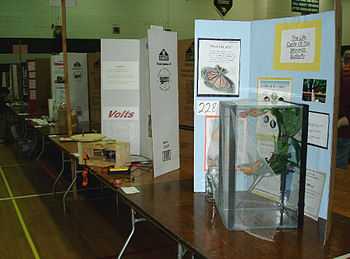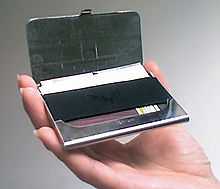Cardboard

Cardboard is a generic term for a heavy-duty paper of various strengths, ranging from a simple arrangement of a single thick sheet of paper to complex configurations featuring multiple corrugated and uncorrugated layers.
Despite widespread use in general English and French,[1][2] the term is deprecated in business and industry.[3] Material producers, container manufacturers,[4] packaging engineers,[5] and standards organizations,[6] try to use more specific terminology. There is still no complete and uniform usage. Often the term "cardboard" is avoided because it does not define any particular material.
History
The term has been used since at least as early as 1683 when, with a publication of that year stating that "The scabbards mentioned in printers' grammars of the last century were of cardboard or millboard".[7] The Kellogg brothers first used paperboard cartons to hold their flaked corn cereal, and later, when they began marketing it to the general public, a heat-sealed bag of Wax paper was wrapped around the outside of the box and printed with their brand name. This marked the origin of the cereal box, though in modern times, the sealed bag is plastic and is kept inside the box rather than outside. Another early American packaging industry pioneer was the Kieckhefer Container Company, run by John W. Kieckhefer, which excelled in the use of fibre shipping containers, which especially included the paper milk carton.
Types
Various card stocks
Various types of cards are available, which may be called "cardboard". Included are: thick paper (of various types) or pasteboard used for business cards, aperture cards, postcards, playing cards, catalog covers, binder's board for bookbinding, scrapbooking, and other uses which require higher durability than regular paper.
Paperboard
Paperboard is a paper-based material, usually more than about ten mils (0.010 inches (0.25 mm)) in thickness. It is often used for folding cartons, set-up boxes, carded packaging, etc. Configurations of paperboard include:
- Containerboard, used in the production of corrugated fiberboard.
- Folding boxboard, made up of multiple layers of chemical and mechanical pulp.
- Solid bleached board is made purely from bleached chemical pulp and usually has a mineral or synthetic pigment.
- Solid unbleached board is typically made of unbleached chemical pulp.
- White lined chipboard is typically made from layers of waste paper or recycled fibers, most often with two to three layers of coating on the top and one layer on the reverse side. Because of its recycled content it will be grey from the inside.
- Binder's board, a paperboard used in bookbinding for making hardcovers.
Modernly, materials falling under these names may be made without using any actual paper.
Corrugated fiberboard
Corrugated fiberboard is a combination of paperboards, usually two flat liners and one inner fluted corrugated medium. It is often used for making corrugated boxes for shipping or storing products. This type of cardboard is also used by artists as original material for sculpting.[8][9]
Recycling
Most types of "cardboard" are recyclable. Boards that are laminates, wax coated, or treated for wet-strength are often more difficult to recycle. Clean cardboard (i.e. cardboard that has not been subject to chemical coatings) "is usually worth recovering, although often the difference between the value it realizes and the cost of recovery is marginal".[10] Cardboard can be recycled industrially, or for home uses. For example, cardboard may be composted or shredded for animal bedding.[11]
Gallery
-
Playing cards
-

A postcard from 1908
-

Posters and display boards at science fair
-

Hardcover book
-

Punch card, early digital storage
-
Mat used for framing picture
-
Hard Cigarette pack or paperboard box
-
Corrugated box used for storage of archives
-

Business cards in a case
-
Fiber tube in roll of paper
-

Paperboard jigsaw puzzle
See also
| Look up cardboard in Wiktionary, the free dictionary. |
References
- ↑
- ↑
- ↑ Walter Soroka, Illustrated Glossary of Packaging Terminology, p. 154
- ↑ What is Corrugated?. Fibre Box Association.
- ↑ Soroka, W. Illustrated Glossary of Packaging Terminology (Second ed.). Institute of Packaging Professionals.
- ↑ D996 Standard Terminology of Packaging, and Distribution Environments. ASTM International. 2004.
- ↑ Joseph Moxon, Theodore Low De Vinne, Moxon's Mechanick exercises; or The doctrine of handy-works applied to the Art of Printing, Volume 2, p. 404
- ↑ http://www.langanart.com/
- ↑ http://www.alexuribe.net
- ↑ AGR Manser, Alan Keeling, Practical Handbook of Processing and Recycling Municipal Waste (1996), p. 298, 8.1.2.
- ↑ Nicky Scott, Reduce, Reuse, Recycle: An Easy Household Guide (2007), p. 31.
| ||||||||||||||||||||||||||||||||||
| ||||||||||||||||||||||||||||||||||||||




